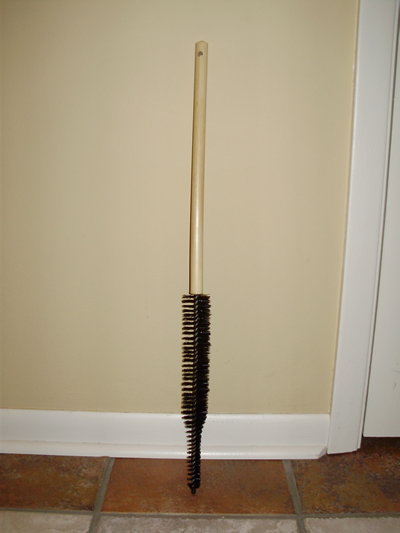
Handyman's
Corner
In the old days, before copper became so valuable, refrigerators had a large passive condenser coil that was mounted on the backside of the refrigerator. These coils required little or no care and maintenance other than being careful not to damage them when moving the refrigerator.
This is not the case with newer refrigerators. If you use a mirror to look behind your modern refrigerator, you'll notice that there is no passive condenser coil mounted on the backside of the unit. This is because the condenser coil on most modern refrigerators is smaller and is mounted under the refrigerator. To increase the efficiency of modern refrigerators and overcome the loss of surface area needed for cooling the refrigerant as it passes through the condenser coil, manufacturers install a fan to draw air from the front of the refrigerator across the condenser coil and out the back of the refrigerator. This design works well if the condenser coil remains unobstructed to allow air to flow freely through the chamber and be drawn out the backside of the chamber by the fan.
This is where the caveat comes into play. Not all owners of refrigerators that use this design are aware of the need to keep the condenser coil and chamber clean and the need to place the refrigerator to allow proper ventilation from behind the refrigerator. If the condenser coil and the intake and exhaust of the chamber are not cleaned periodically, dust, pet hair, and other debris begins to collect at the intake, upon the coil, and at the exhaust of the condenser coil chamber. This lowers the efficiency of the refrigeration unit and causes the compressor and fans to run for a longer period of time during operational cycles. In extreme cases, if the condenser coil chamber has become blocked to the point where little if any air is flowing through the chamber across the condenser coil, then the refrigeration unit runs for prolonged periods in an attempt to cool the interior of the refrigerator. This can cause the compressor or one of the fans to fail as they are designed to cycle on and off and are not designed for continuous use.
Before attempting to clean your condenser coil and condenser coil chamber, I suggest you refer to your owner's manual for your specific unit. If you do not have the owner's manual, you can usually find a digital copy of it on the manufacturers website. Cleaning the condenser coil and ensuring proper airflow through the condenser chamber requires a few simple tools and little specialized skill. Most modern refrigerators have a removable grill panel at the bottom front of the unit. This grill panel protects the condenser coil from being damaged so it is important that the grill panel is replaced after cleaning. Begin the cleaning process by removing the grill panel to expose the front of the condenser coil where much of the build-up of debris accumulates. The grill panel on our unit is plastic, so I take it outside and spray it clean with the hose and allow it to air dry.
Next, I use a vacuum cleaner with a plastic nozzle attachment to vacuum the debris from the front of the coil. I then use a coil brush I purchased from a local hardware store to clean the coil itself. When using a coil brush, make sure the protective tip at the end of the brush remains in place. This covering over the metal tip protects the coil from being damaged by the coil brush. Never use the coil brush without this tip cover in place. If you lose the tip, replace the coil brush rather than run the risk of puncturing the condenser coil and creating the need for a major repair. Cleaning the condenser coil is accomplished by running the coil brush in and out above and between the coils. This should require only slight pressure to push the brush in and then draw it back out. If you encounter unusual pressure while inserting the coil brush, then draw it back out and reinsert it in a slightly different location or at a slightly different angle. Each time the coil brush is drawn out, clean the debris from the brush before reinserting it. Once this process is complete, there is only one more procedure I use in this process.
Most modern refrigerators are on wheels. As the last step in this process, I usually pull the refrigerator away from the wall to expose all of the floor area where it sits. I clean the floor under the refrigerator and vacuum the grill of the exhaust fan as necessary. I usually clean our refrigerator once every 6 months. If you begin this periodic maintenance for your own unit, after a few cleanings, it will become apparent how often you need to do this maintenance.
Sample Coil Brush
